Financial Resource Management Report: Sainsbury's Business Analysis
VerifiedAdded on 2019/12/03
|15
|4215
|23
Report
AI Summary
This report provides a comprehensive analysis of financial resource management, focusing on the case of Sainsbury. It begins by identifying and evaluating various sources of finance available to businesses, including internal and external options like retained earnings, bank loans, and the issuance of shares, while also exploring the implications of each source in terms of cost, control, and potential risks. The report then delves into the importance of financial planning, highlighting its role in effective cash management, identifying financial needs, and understanding financial statements. Furthermore, the report includes an analysis of budgets, specifically a six-month cash budget for Sainsbury, and assesses the viability of projects through financial statement interpretation using ratios. The analysis extends to identifying the information needs of both internal and external decision-makers, and how finance impacts financial statements. The report concludes with an overview of key financial statements, appropriate formats for different business types, and the interpretation of these statements through ratio analysis, providing a holistic view of financial management within the context of a real-world business.
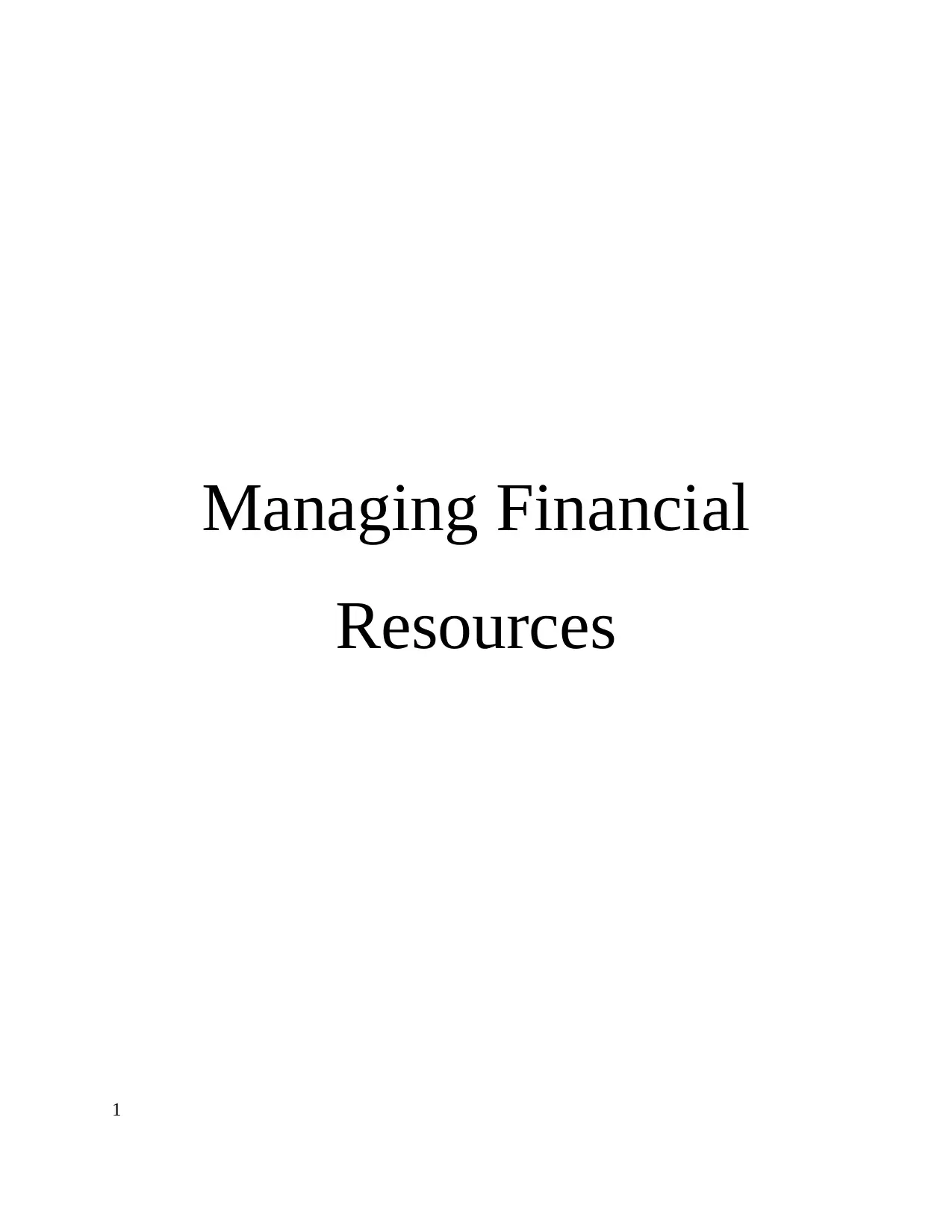
Managing Financial
Resources
1
Resources
1
Paraphrase This Document
Need a fresh take? Get an instant paraphrase of this document with our AI Paraphraser
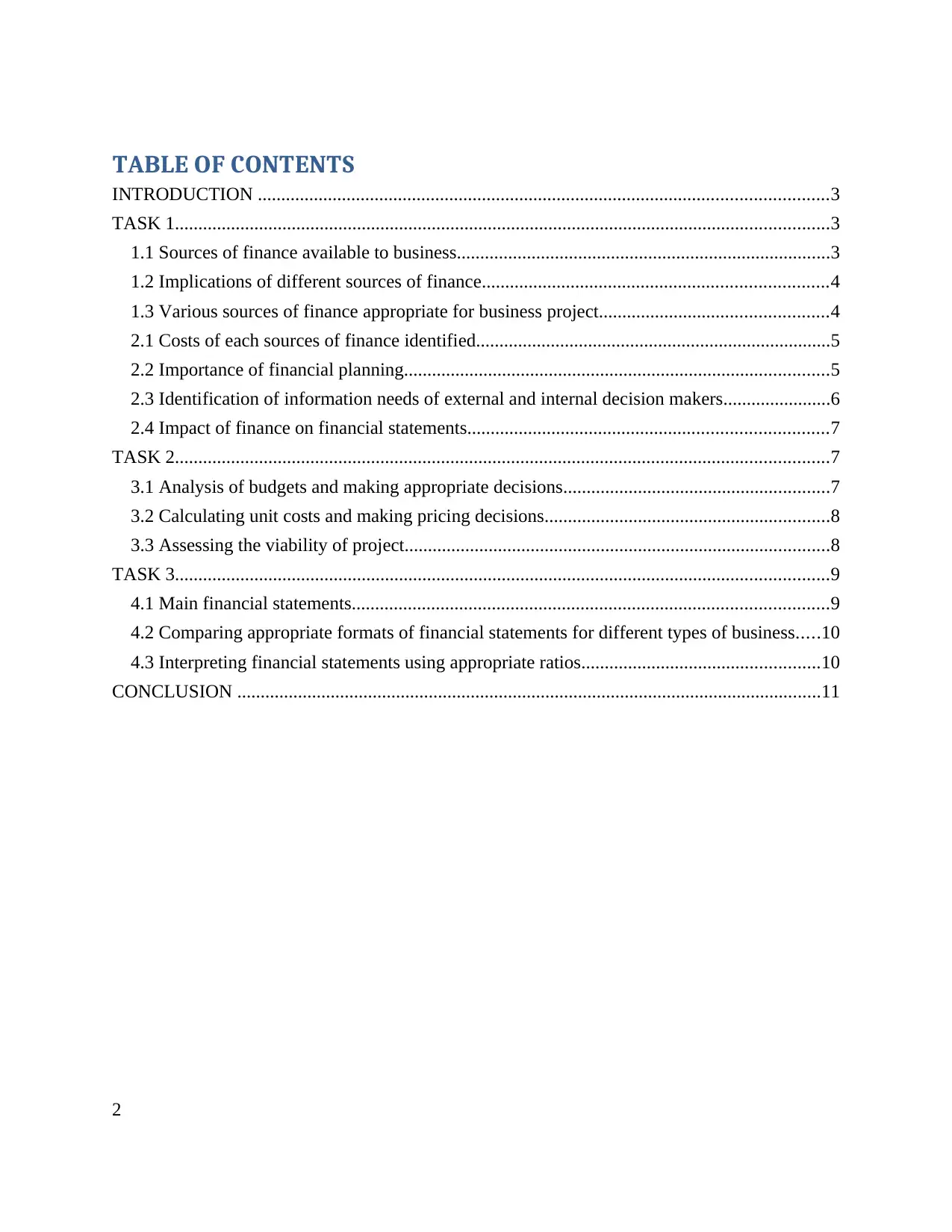
TABLE OF CONTENTS
INTRODUCTION ..........................................................................................................................3
TASK 1............................................................................................................................................3
1.1 Sources of finance available to business................................................................................3
1.2 Implications of different sources of finance..........................................................................4
1.3 Various sources of finance appropriate for business project.................................................4
2.1 Costs of each sources of finance identified............................................................................5
2.2 Importance of financial planning...........................................................................................5
2.3 Identification of information needs of external and internal decision makers.......................6
2.4 Impact of finance on financial statements.............................................................................7
TASK 2............................................................................................................................................7
3.1 Analysis of budgets and making appropriate decisions.........................................................7
3.2 Calculating unit costs and making pricing decisions.............................................................8
3.3 Assessing the viability of project...........................................................................................8
TASK 3............................................................................................................................................9
4.1 Main financial statements......................................................................................................9
4.2 Comparing appropriate formats of financial statements for different types of business.....10
4.3 Interpreting financial statements using appropriate ratios...................................................10
CONCLUSION .............................................................................................................................11
2
INTRODUCTION ..........................................................................................................................3
TASK 1............................................................................................................................................3
1.1 Sources of finance available to business................................................................................3
1.2 Implications of different sources of finance..........................................................................4
1.3 Various sources of finance appropriate for business project.................................................4
2.1 Costs of each sources of finance identified............................................................................5
2.2 Importance of financial planning...........................................................................................5
2.3 Identification of information needs of external and internal decision makers.......................6
2.4 Impact of finance on financial statements.............................................................................7
TASK 2............................................................................................................................................7
3.1 Analysis of budgets and making appropriate decisions.........................................................7
3.2 Calculating unit costs and making pricing decisions.............................................................8
3.3 Assessing the viability of project...........................................................................................8
TASK 3............................................................................................................................................9
4.1 Main financial statements......................................................................................................9
4.2 Comparing appropriate formats of financial statements for different types of business.....10
4.3 Interpreting financial statements using appropriate ratios...................................................10
CONCLUSION .............................................................................................................................11
2
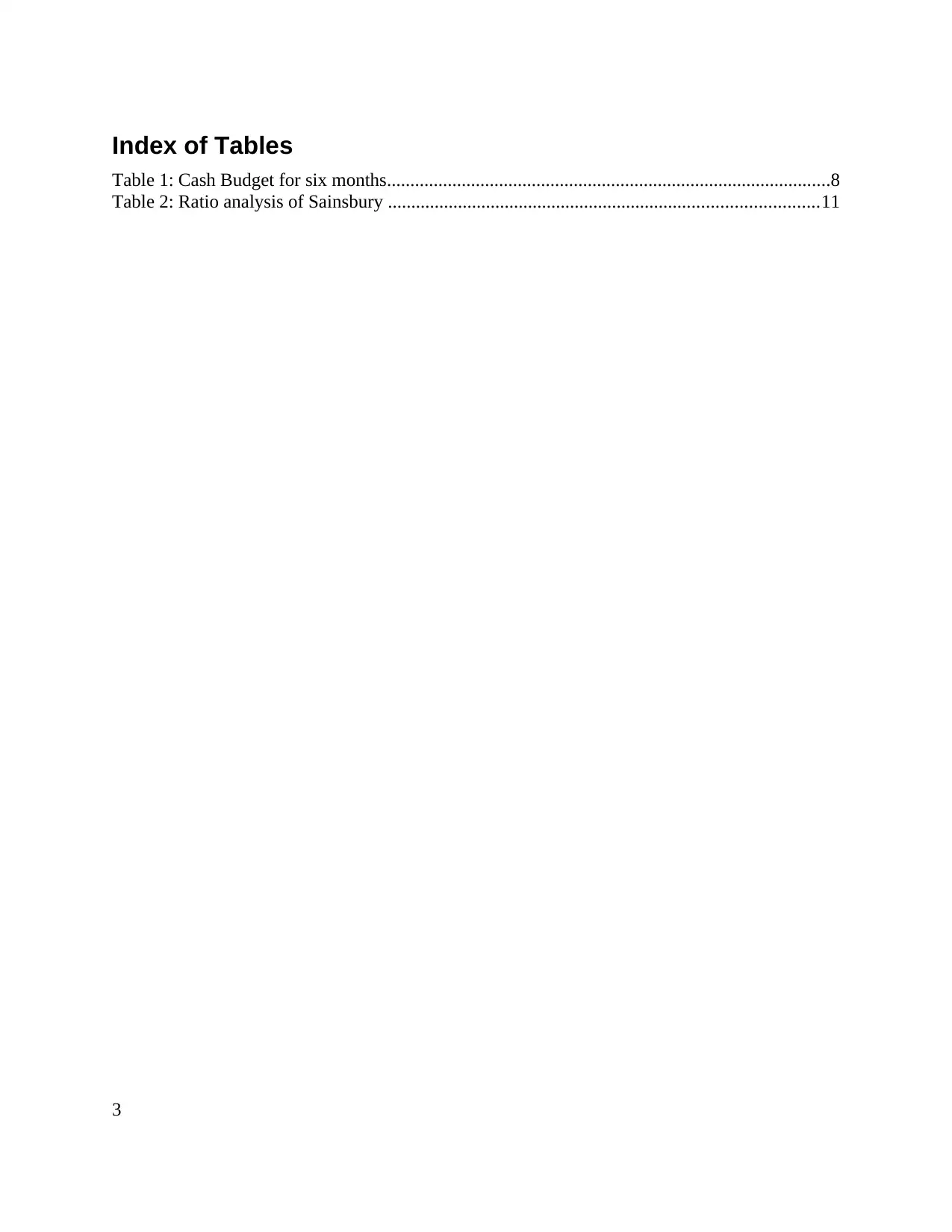
Index of Tables
Table 1: Cash Budget for six months...............................................................................................8
Table 2: Ratio analysis of Sainsbury ............................................................................................11
3
Table 1: Cash Budget for six months...............................................................................................8
Table 2: Ratio analysis of Sainsbury ............................................................................................11
3
⊘ This is a preview!⊘
Do you want full access?
Subscribe today to unlock all pages.

Trusted by 1+ million students worldwide
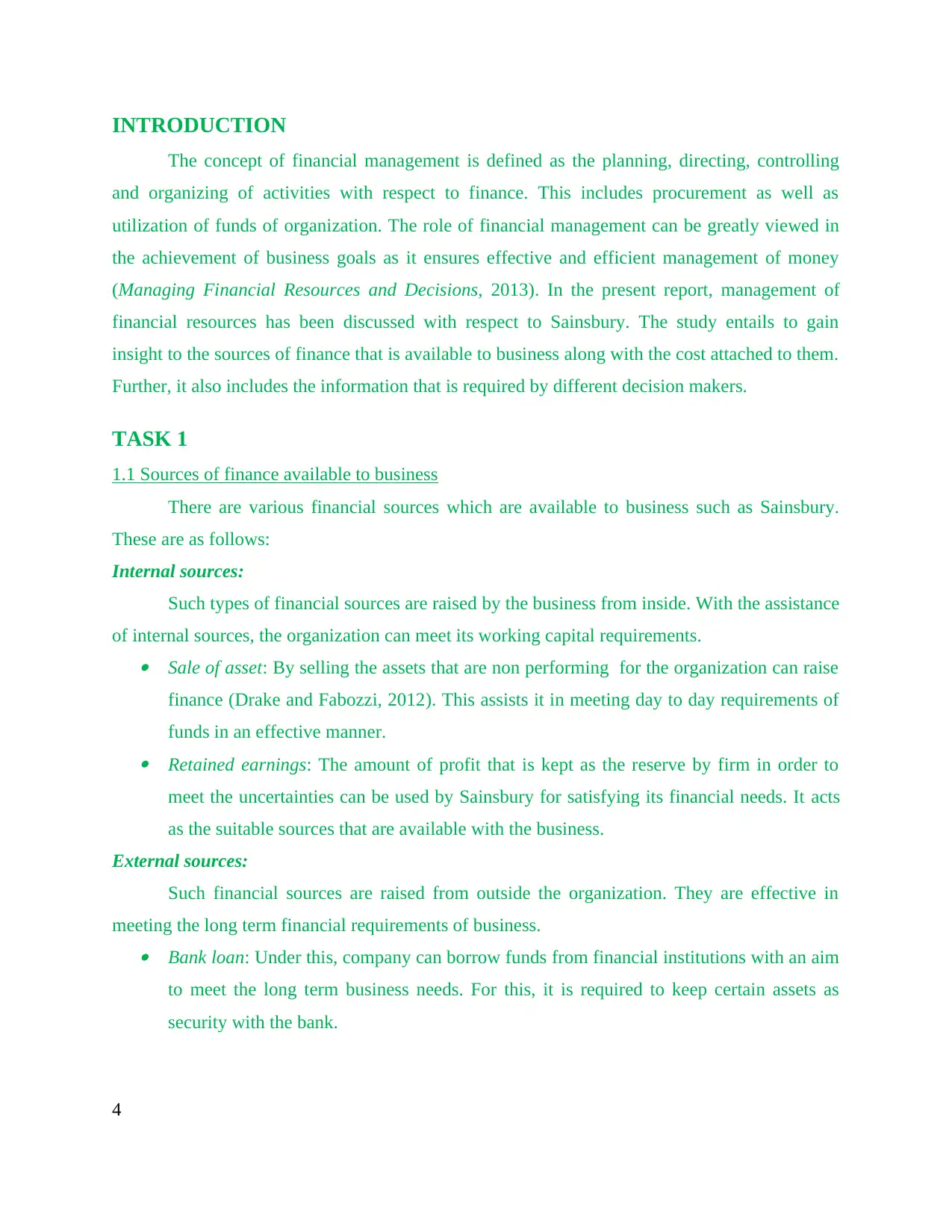
INTRODUCTION
The concept of financial management is defined as the planning, directing, controlling
and organizing of activities with respect to finance. This includes procurement as well as
utilization of funds of organization. The role of financial management can be greatly viewed in
the achievement of business goals as it ensures effective and efficient management of money
(Managing Financial Resources and Decisions, 2013). In the present report, management of
financial resources has been discussed with respect to Sainsbury. The study entails to gain
insight to the sources of finance that is available to business along with the cost attached to them.
Further, it also includes the information that is required by different decision makers.
TASK 1
1.1 Sources of finance available to business
There are various financial sources which are available to business such as Sainsbury.
These are as follows:
Internal sources:
Such types of financial sources are raised by the business from inside. With the assistance
of internal sources, the organization can meet its working capital requirements. Sale of asset: By selling the assets that are non performing for the organization can raise
finance (Drake and Fabozzi, 2012). This assists it in meeting day to day requirements of
funds in an effective manner. Retained earnings: The amount of profit that is kept as the reserve by firm in order to
meet the uncertainties can be used by Sainsbury for satisfying its financial needs. It acts
as the suitable sources that are available with the business.
External sources:
Such financial sources are raised from outside the organization. They are effective in
meeting the long term financial requirements of business. Bank loan: Under this, company can borrow funds from financial institutions with an aim
to meet the long term business needs. For this, it is required to keep certain assets as
security with the bank.
4
The concept of financial management is defined as the planning, directing, controlling
and organizing of activities with respect to finance. This includes procurement as well as
utilization of funds of organization. The role of financial management can be greatly viewed in
the achievement of business goals as it ensures effective and efficient management of money
(Managing Financial Resources and Decisions, 2013). In the present report, management of
financial resources has been discussed with respect to Sainsbury. The study entails to gain
insight to the sources of finance that is available to business along with the cost attached to them.
Further, it also includes the information that is required by different decision makers.
TASK 1
1.1 Sources of finance available to business
There are various financial sources which are available to business such as Sainsbury.
These are as follows:
Internal sources:
Such types of financial sources are raised by the business from inside. With the assistance
of internal sources, the organization can meet its working capital requirements. Sale of asset: By selling the assets that are non performing for the organization can raise
finance (Drake and Fabozzi, 2012). This assists it in meeting day to day requirements of
funds in an effective manner. Retained earnings: The amount of profit that is kept as the reserve by firm in order to
meet the uncertainties can be used by Sainsbury for satisfying its financial needs. It acts
as the suitable sources that are available with the business.
External sources:
Such financial sources are raised from outside the organization. They are effective in
meeting the long term financial requirements of business. Bank loan: Under this, company can borrow funds from financial institutions with an aim
to meet the long term business needs. For this, it is required to keep certain assets as
security with the bank.
4
Paraphrase This Document
Need a fresh take? Get an instant paraphrase of this document with our AI Paraphraser
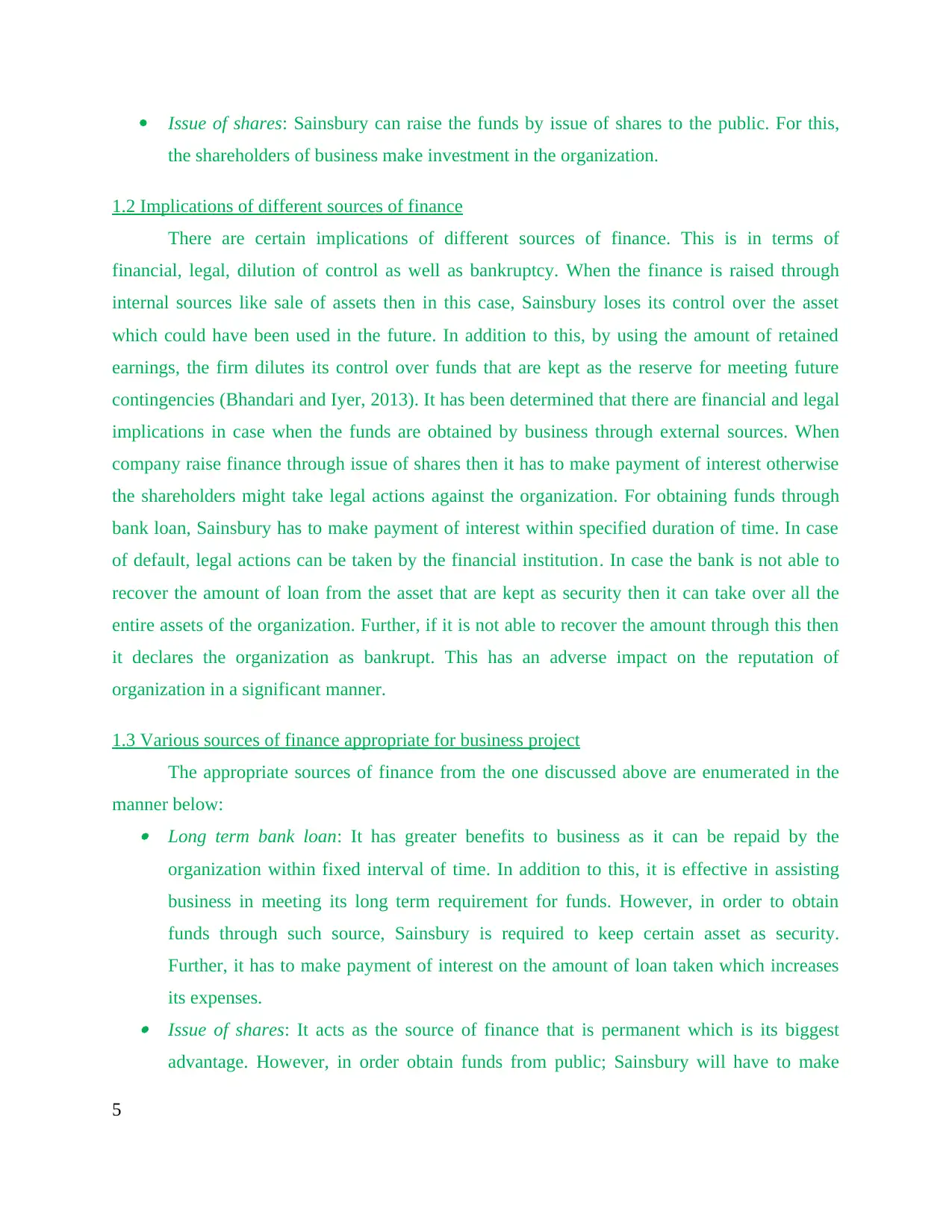
Issue of shares: Sainsbury can raise the funds by issue of shares to the public. For this,
the shareholders of business make investment in the organization.
1.2 Implications of different sources of finance
There are certain implications of different sources of finance. This is in terms of
financial, legal, dilution of control as well as bankruptcy. When the finance is raised through
internal sources like sale of assets then in this case, Sainsbury loses its control over the asset
which could have been used in the future. In addition to this, by using the amount of retained
earnings, the firm dilutes its control over funds that are kept as the reserve for meeting future
contingencies (Bhandari and Iyer, 2013). It has been determined that there are financial and legal
implications in case when the funds are obtained by business through external sources. When
company raise finance through issue of shares then it has to make payment of interest otherwise
the shareholders might take legal actions against the organization. For obtaining funds through
bank loan, Sainsbury has to make payment of interest within specified duration of time. In case
of default, legal actions can be taken by the financial institution. In case the bank is not able to
recover the amount of loan from the asset that are kept as security then it can take over all the
entire assets of the organization. Further, if it is not able to recover the amount through this then
it declares the organization as bankrupt. This has an adverse impact on the reputation of
organization in a significant manner.
1.3 Various sources of finance appropriate for business project
The appropriate sources of finance from the one discussed above are enumerated in the
manner below: Long term bank loan: It has greater benefits to business as it can be repaid by the
organization within fixed interval of time. In addition to this, it is effective in assisting
business in meeting its long term requirement for funds. However, in order to obtain
funds through such source, Sainsbury is required to keep certain asset as security.
Further, it has to make payment of interest on the amount of loan taken which increases
its expenses. Issue of shares: It acts as the source of finance that is permanent which is its biggest
advantage. However, in order obtain funds from public; Sainsbury will have to make
5
the shareholders of business make investment in the organization.
1.2 Implications of different sources of finance
There are certain implications of different sources of finance. This is in terms of
financial, legal, dilution of control as well as bankruptcy. When the finance is raised through
internal sources like sale of assets then in this case, Sainsbury loses its control over the asset
which could have been used in the future. In addition to this, by using the amount of retained
earnings, the firm dilutes its control over funds that are kept as the reserve for meeting future
contingencies (Bhandari and Iyer, 2013). It has been determined that there are financial and legal
implications in case when the funds are obtained by business through external sources. When
company raise finance through issue of shares then it has to make payment of interest otherwise
the shareholders might take legal actions against the organization. For obtaining funds through
bank loan, Sainsbury has to make payment of interest within specified duration of time. In case
of default, legal actions can be taken by the financial institution. In case the bank is not able to
recover the amount of loan from the asset that are kept as security then it can take over all the
entire assets of the organization. Further, if it is not able to recover the amount through this then
it declares the organization as bankrupt. This has an adverse impact on the reputation of
organization in a significant manner.
1.3 Various sources of finance appropriate for business project
The appropriate sources of finance from the one discussed above are enumerated in the
manner below: Long term bank loan: It has greater benefits to business as it can be repaid by the
organization within fixed interval of time. In addition to this, it is effective in assisting
business in meeting its long term requirement for funds. However, in order to obtain
funds through such source, Sainsbury is required to keep certain asset as security.
Further, it has to make payment of interest on the amount of loan taken which increases
its expenses. Issue of shares: It acts as the source of finance that is permanent which is its biggest
advantage. However, in order obtain funds from public; Sainsbury will have to make
5
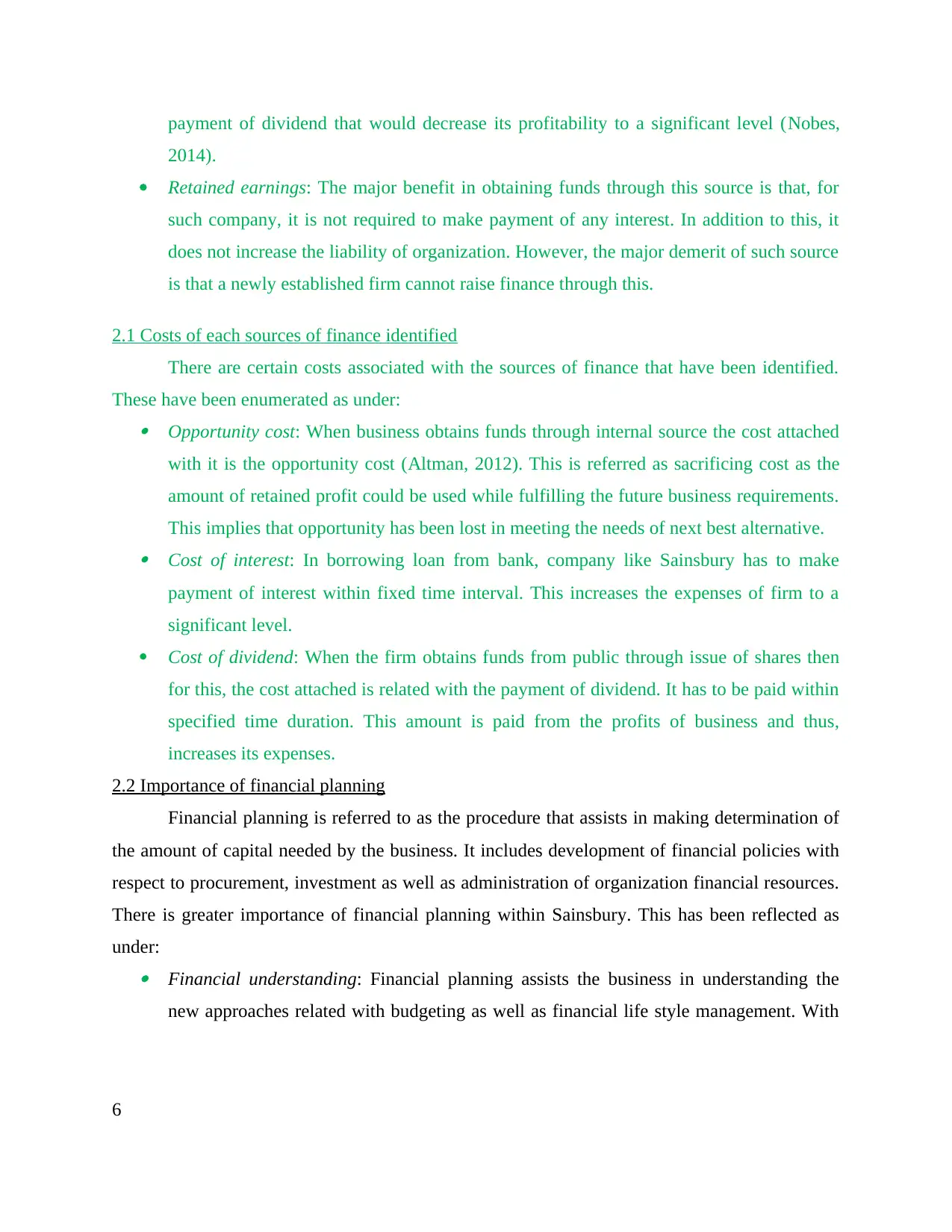
payment of dividend that would decrease its profitability to a significant level (Nobes,
2014).
Retained earnings: The major benefit in obtaining funds through this source is that, for
such company, it is not required to make payment of any interest. In addition to this, it
does not increase the liability of organization. However, the major demerit of such source
is that a newly established firm cannot raise finance through this.
2.1 Costs of each sources of finance identified
There are certain costs associated with the sources of finance that have been identified.
These have been enumerated as under: Opportunity cost: When business obtains funds through internal source the cost attached
with it is the opportunity cost (Altman, 2012). This is referred as sacrificing cost as the
amount of retained profit could be used while fulfilling the future business requirements.
This implies that opportunity has been lost in meeting the needs of next best alternative. Cost of interest: In borrowing loan from bank, company like Sainsbury has to make
payment of interest within fixed time interval. This increases the expenses of firm to a
significant level.
Cost of dividend: When the firm obtains funds from public through issue of shares then
for this, the cost attached is related with the payment of dividend. It has to be paid within
specified time duration. This amount is paid from the profits of business and thus,
increases its expenses.
2.2 Importance of financial planning
Financial planning is referred to as the procedure that assists in making determination of
the amount of capital needed by the business. It includes development of financial policies with
respect to procurement, investment as well as administration of organization financial resources.
There is greater importance of financial planning within Sainsbury. This has been reflected as
under: Financial understanding: Financial planning assists the business in understanding the
new approaches related with budgeting as well as financial life style management. With
6
2014).
Retained earnings: The major benefit in obtaining funds through this source is that, for
such company, it is not required to make payment of any interest. In addition to this, it
does not increase the liability of organization. However, the major demerit of such source
is that a newly established firm cannot raise finance through this.
2.1 Costs of each sources of finance identified
There are certain costs associated with the sources of finance that have been identified.
These have been enumerated as under: Opportunity cost: When business obtains funds through internal source the cost attached
with it is the opportunity cost (Altman, 2012). This is referred as sacrificing cost as the
amount of retained profit could be used while fulfilling the future business requirements.
This implies that opportunity has been lost in meeting the needs of next best alternative. Cost of interest: In borrowing loan from bank, company like Sainsbury has to make
payment of interest within fixed time interval. This increases the expenses of firm to a
significant level.
Cost of dividend: When the firm obtains funds from public through issue of shares then
for this, the cost attached is related with the payment of dividend. It has to be paid within
specified time duration. This amount is paid from the profits of business and thus,
increases its expenses.
2.2 Importance of financial planning
Financial planning is referred to as the procedure that assists in making determination of
the amount of capital needed by the business. It includes development of financial policies with
respect to procurement, investment as well as administration of organization financial resources.
There is greater importance of financial planning within Sainsbury. This has been reflected as
under: Financial understanding: Financial planning assists the business in understanding the
new approaches related with budgeting as well as financial life style management. With
6
⊘ This is a preview!⊘
Do you want full access?
Subscribe today to unlock all pages.

Trusted by 1+ million students worldwide
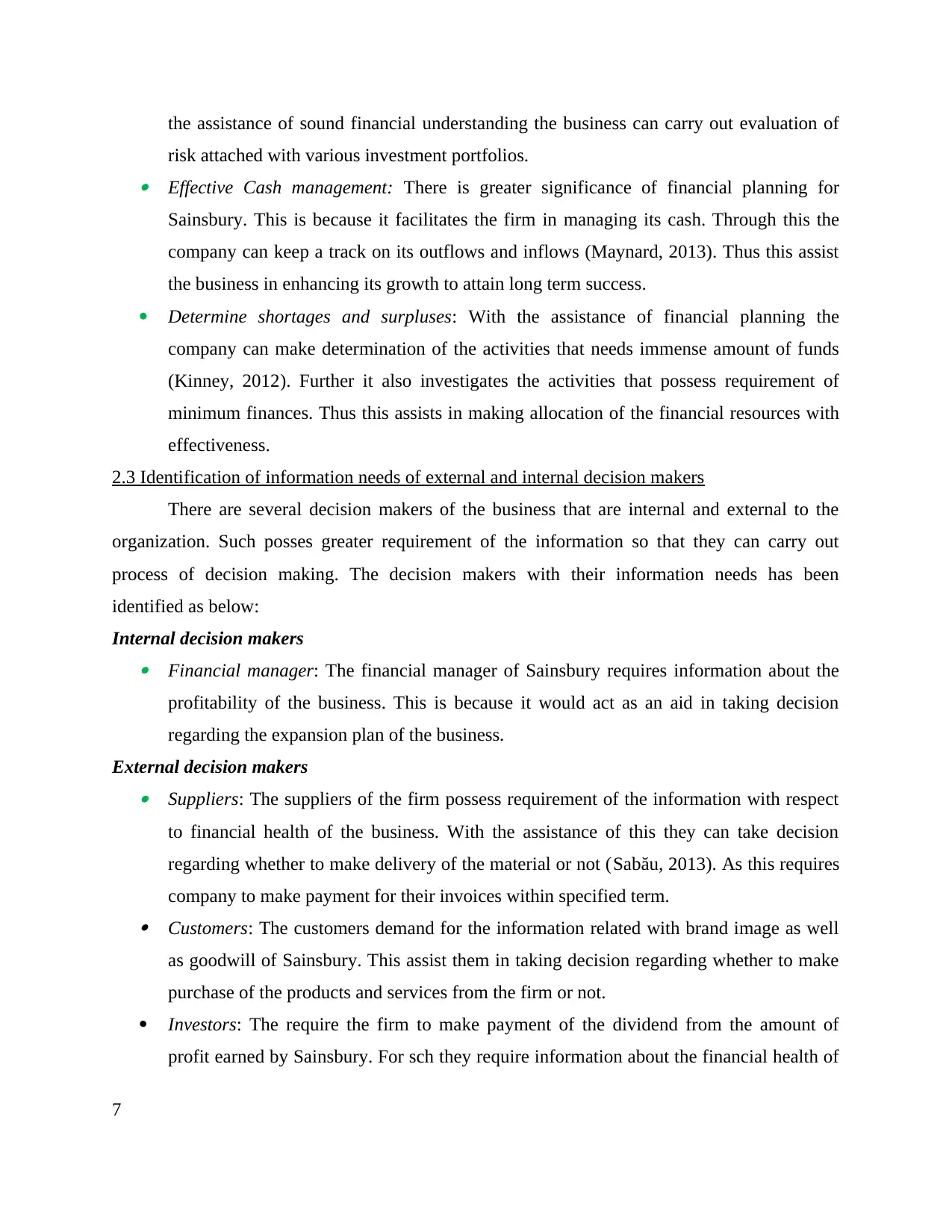
the assistance of sound financial understanding the business can carry out evaluation of
risk attached with various investment portfolios. Effective Cash management: There is greater significance of financial planning for
Sainsbury. This is because it facilitates the firm in managing its cash. Through this the
company can keep a track on its outflows and inflows (Maynard, 2013). Thus this assist
the business in enhancing its growth to attain long term success.
Determine shortages and surpluses: With the assistance of financial planning the
company can make determination of the activities that needs immense amount of funds
(Kinney, 2012). Further it also investigates the activities that possess requirement of
minimum finances. Thus this assists in making allocation of the financial resources with
effectiveness.
2.3 Identification of information needs of external and internal decision makers
There are several decision makers of the business that are internal and external to the
organization. Such posses greater requirement of the information so that they can carry out
process of decision making. The decision makers with their information needs has been
identified as below:
Internal decision makers Financial manager: The financial manager of Sainsbury requires information about the
profitability of the business. This is because it would act as an aid in taking decision
regarding the expansion plan of the business.
External decision makers Suppliers: The suppliers of the firm possess requirement of the information with respect
to financial health of the business. With the assistance of this they can take decision
regarding whether to make delivery of the material or not (Sabău, 2013). As this requires
company to make payment for their invoices within specified term. Customers: The customers demand for the information related with brand image as well
as goodwill of Sainsbury. This assist them in taking decision regarding whether to make
purchase of the products and services from the firm or not.
Investors: The require the firm to make payment of the dividend from the amount of
profit earned by Sainsbury. For sch they require information about the financial health of
7
risk attached with various investment portfolios. Effective Cash management: There is greater significance of financial planning for
Sainsbury. This is because it facilitates the firm in managing its cash. Through this the
company can keep a track on its outflows and inflows (Maynard, 2013). Thus this assist
the business in enhancing its growth to attain long term success.
Determine shortages and surpluses: With the assistance of financial planning the
company can make determination of the activities that needs immense amount of funds
(Kinney, 2012). Further it also investigates the activities that possess requirement of
minimum finances. Thus this assists in making allocation of the financial resources with
effectiveness.
2.3 Identification of information needs of external and internal decision makers
There are several decision makers of the business that are internal and external to the
organization. Such posses greater requirement of the information so that they can carry out
process of decision making. The decision makers with their information needs has been
identified as below:
Internal decision makers Financial manager: The financial manager of Sainsbury requires information about the
profitability of the business. This is because it would act as an aid in taking decision
regarding the expansion plan of the business.
External decision makers Suppliers: The suppliers of the firm possess requirement of the information with respect
to financial health of the business. With the assistance of this they can take decision
regarding whether to make delivery of the material or not (Sabău, 2013). As this requires
company to make payment for their invoices within specified term. Customers: The customers demand for the information related with brand image as well
as goodwill of Sainsbury. This assist them in taking decision regarding whether to make
purchase of the products and services from the firm or not.
Investors: The require the firm to make payment of the dividend from the amount of
profit earned by Sainsbury. For sch they require information about the financial health of
7
Paraphrase This Document
Need a fresh take? Get an instant paraphrase of this document with our AI Paraphraser
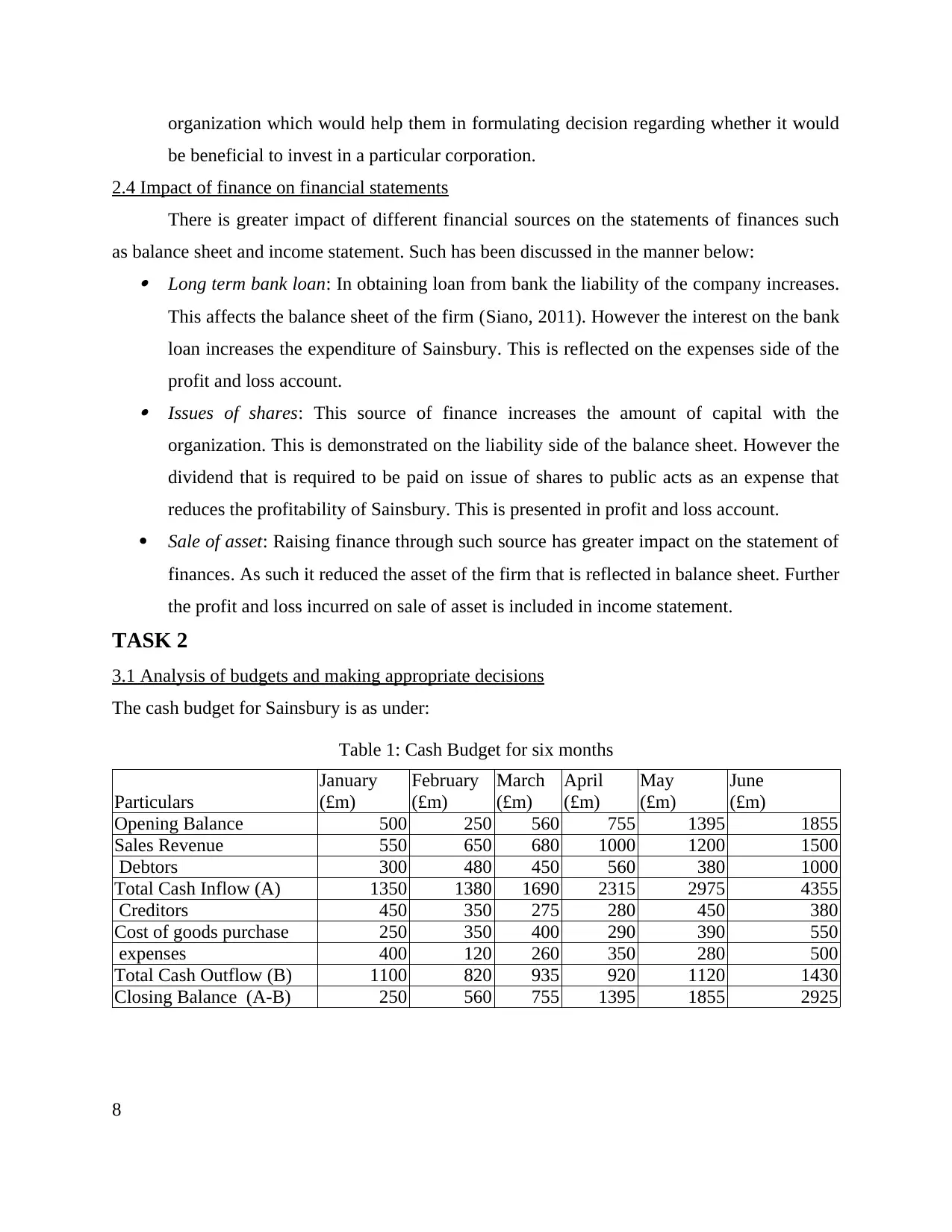
organization which would help them in formulating decision regarding whether it would
be beneficial to invest in a particular corporation.
2.4 Impact of finance on financial statements
There is greater impact of different financial sources on the statements of finances such
as balance sheet and income statement. Such has been discussed in the manner below: Long term bank loan: In obtaining loan from bank the liability of the company increases.
This affects the balance sheet of the firm (Siano, 2011). However the interest on the bank
loan increases the expenditure of Sainsbury. This is reflected on the expenses side of the
profit and loss account. Issues of shares: This source of finance increases the amount of capital with the
organization. This is demonstrated on the liability side of the balance sheet. However the
dividend that is required to be paid on issue of shares to public acts as an expense that
reduces the profitability of Sainsbury. This is presented in profit and loss account.
Sale of asset: Raising finance through such source has greater impact on the statement of
finances. As such it reduced the asset of the firm that is reflected in balance sheet. Further
the profit and loss incurred on sale of asset is included in income statement.
TASK 2
3.1 Analysis of budgets and making appropriate decisions
The cash budget for Sainsbury is as under:
Table 1: Cash Budget for six months
Particulars
January
(£m)
February
(£m)
March
(£m)
April
(£m)
May
(£m)
June
(£m)
Opening Balance 500 250 560 755 1395 1855
Sales Revenue 550 650 680 1000 1200 1500
Debtors 300 480 450 560 380 1000
Total Cash Inflow (A) 1350 1380 1690 2315 2975 4355
Creditors 450 350 275 280 450 380
Cost of goods purchase 250 350 400 290 390 550
expenses 400 120 260 350 280 500
Total Cash Outflow (B) 1100 820 935 920 1120 1430
Closing Balance (A-B) 250 560 755 1395 1855 2925
8
be beneficial to invest in a particular corporation.
2.4 Impact of finance on financial statements
There is greater impact of different financial sources on the statements of finances such
as balance sheet and income statement. Such has been discussed in the manner below: Long term bank loan: In obtaining loan from bank the liability of the company increases.
This affects the balance sheet of the firm (Siano, 2011). However the interest on the bank
loan increases the expenditure of Sainsbury. This is reflected on the expenses side of the
profit and loss account. Issues of shares: This source of finance increases the amount of capital with the
organization. This is demonstrated on the liability side of the balance sheet. However the
dividend that is required to be paid on issue of shares to public acts as an expense that
reduces the profitability of Sainsbury. This is presented in profit and loss account.
Sale of asset: Raising finance through such source has greater impact on the statement of
finances. As such it reduced the asset of the firm that is reflected in balance sheet. Further
the profit and loss incurred on sale of asset is included in income statement.
TASK 2
3.1 Analysis of budgets and making appropriate decisions
The cash budget for Sainsbury is as under:
Table 1: Cash Budget for six months
Particulars
January
(£m)
February
(£m)
March
(£m)
April
(£m)
May
(£m)
June
(£m)
Opening Balance 500 250 560 755 1395 1855
Sales Revenue 550 650 680 1000 1200 1500
Debtors 300 480 450 560 380 1000
Total Cash Inflow (A) 1350 1380 1690 2315 2975 4355
Creditors 450 350 275 280 450 380
Cost of goods purchase 250 350 400 290 390 550
expenses 400 120 260 350 280 500
Total Cash Outflow (B) 1100 820 935 920 1120 1430
Closing Balance (A-B) 250 560 755 1395 1855 2925
8
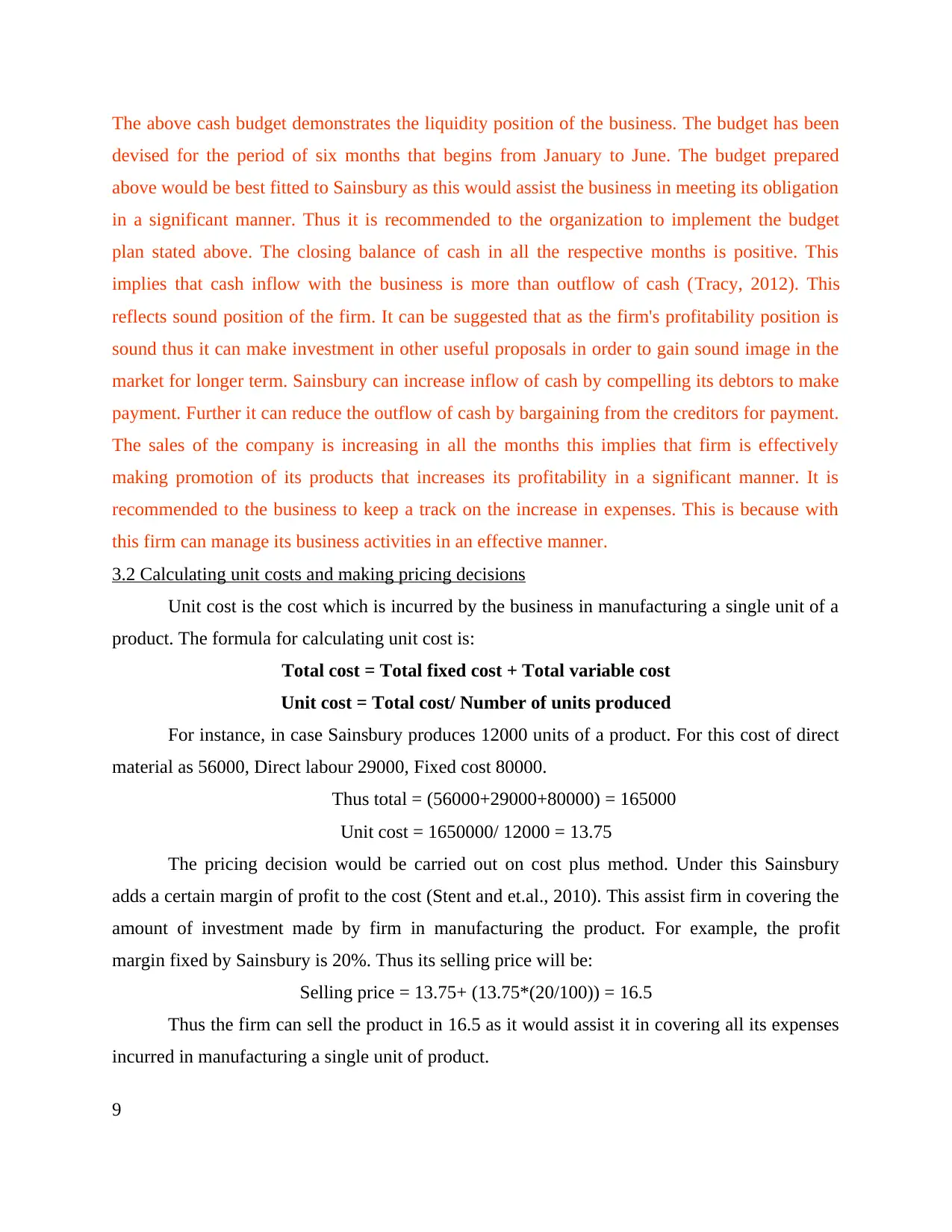
The above cash budget demonstrates the liquidity position of the business. The budget has been
devised for the period of six months that begins from January to June. The budget prepared
above would be best fitted to Sainsbury as this would assist the business in meeting its obligation
in a significant manner. Thus it is recommended to the organization to implement the budget
plan stated above. The closing balance of cash in all the respective months is positive. This
implies that cash inflow with the business is more than outflow of cash (Tracy, 2012). This
reflects sound position of the firm. It can be suggested that as the firm's profitability position is
sound thus it can make investment in other useful proposals in order to gain sound image in the
market for longer term. Sainsbury can increase inflow of cash by compelling its debtors to make
payment. Further it can reduce the outflow of cash by bargaining from the creditors for payment.
The sales of the company is increasing in all the months this implies that firm is effectively
making promotion of its products that increases its profitability in a significant manner. It is
recommended to the business to keep a track on the increase in expenses. This is because with
this firm can manage its business activities in an effective manner.
3.2 Calculating unit costs and making pricing decisions
Unit cost is the cost which is incurred by the business in manufacturing a single unit of a
product. The formula for calculating unit cost is:
Total cost = Total fixed cost + Total variable cost
Unit cost = Total cost/ Number of units produced
For instance, in case Sainsbury produces 12000 units of a product. For this cost of direct
material as 56000, Direct labour 29000, Fixed cost 80000.
Thus total = (56000+29000+80000) = 165000
Unit cost = 1650000/ 12000 = 13.75
The pricing decision would be carried out on cost plus method. Under this Sainsbury
adds a certain margin of profit to the cost (Stent and et.al., 2010). This assist firm in covering the
amount of investment made by firm in manufacturing the product. For example, the profit
margin fixed by Sainsbury is 20%. Thus its selling price will be:
Selling price = 13.75+ (13.75*(20/100)) = 16.5
Thus the firm can sell the product in 16.5 as it would assist it in covering all its expenses
incurred in manufacturing a single unit of product.
9
devised for the period of six months that begins from January to June. The budget prepared
above would be best fitted to Sainsbury as this would assist the business in meeting its obligation
in a significant manner. Thus it is recommended to the organization to implement the budget
plan stated above. The closing balance of cash in all the respective months is positive. This
implies that cash inflow with the business is more than outflow of cash (Tracy, 2012). This
reflects sound position of the firm. It can be suggested that as the firm's profitability position is
sound thus it can make investment in other useful proposals in order to gain sound image in the
market for longer term. Sainsbury can increase inflow of cash by compelling its debtors to make
payment. Further it can reduce the outflow of cash by bargaining from the creditors for payment.
The sales of the company is increasing in all the months this implies that firm is effectively
making promotion of its products that increases its profitability in a significant manner. It is
recommended to the business to keep a track on the increase in expenses. This is because with
this firm can manage its business activities in an effective manner.
3.2 Calculating unit costs and making pricing decisions
Unit cost is the cost which is incurred by the business in manufacturing a single unit of a
product. The formula for calculating unit cost is:
Total cost = Total fixed cost + Total variable cost
Unit cost = Total cost/ Number of units produced
For instance, in case Sainsbury produces 12000 units of a product. For this cost of direct
material as 56000, Direct labour 29000, Fixed cost 80000.
Thus total = (56000+29000+80000) = 165000
Unit cost = 1650000/ 12000 = 13.75
The pricing decision would be carried out on cost plus method. Under this Sainsbury
adds a certain margin of profit to the cost (Stent and et.al., 2010). This assist firm in covering the
amount of investment made by firm in manufacturing the product. For example, the profit
margin fixed by Sainsbury is 20%. Thus its selling price will be:
Selling price = 13.75+ (13.75*(20/100)) = 16.5
Thus the firm can sell the product in 16.5 as it would assist it in covering all its expenses
incurred in manufacturing a single unit of product.
9
⊘ This is a preview!⊘
Do you want full access?
Subscribe today to unlock all pages.

Trusted by 1+ million students worldwide
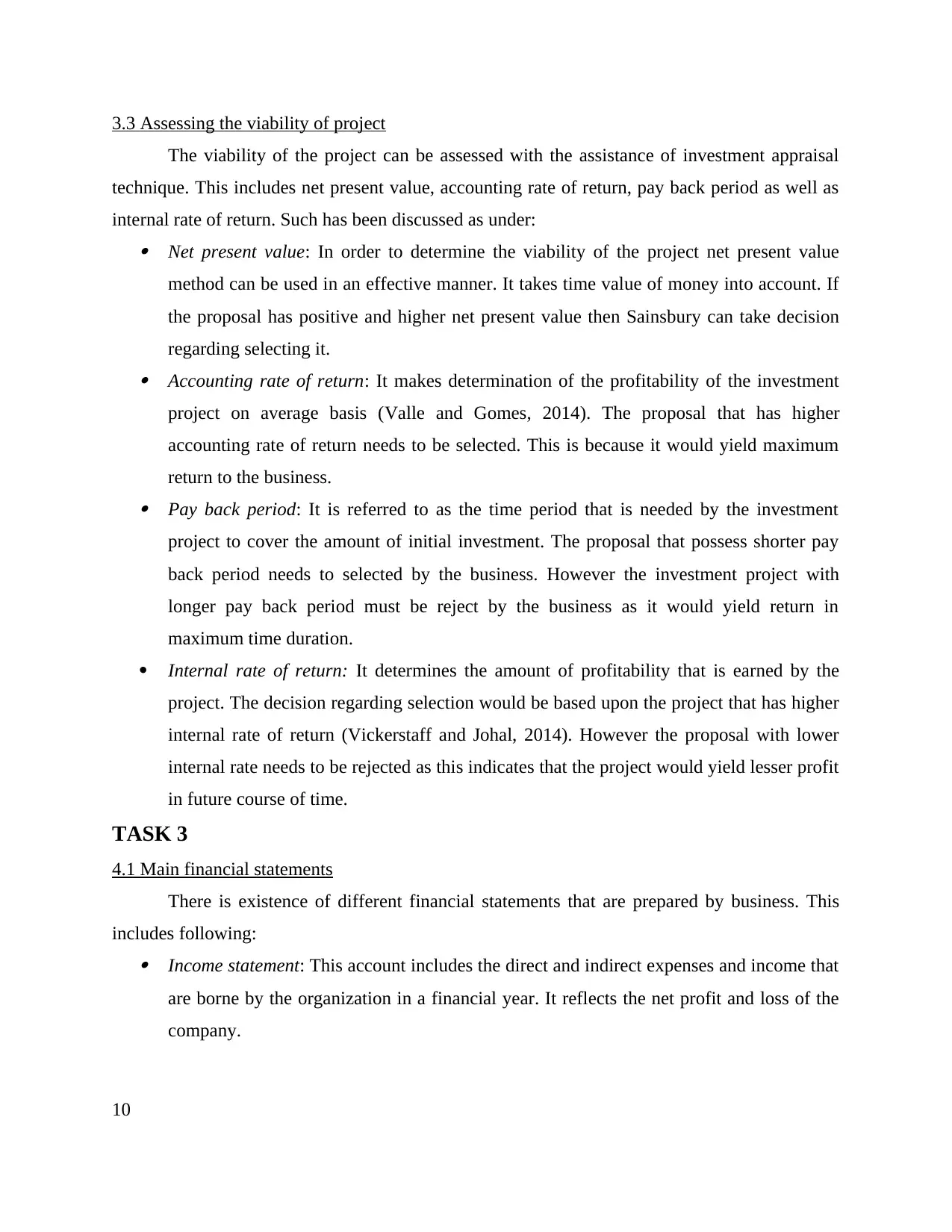
3.3 Assessing the viability of project
The viability of the project can be assessed with the assistance of investment appraisal
technique. This includes net present value, accounting rate of return, pay back period as well as
internal rate of return. Such has been discussed as under: Net present value: In order to determine the viability of the project net present value
method can be used in an effective manner. It takes time value of money into account. If
the proposal has positive and higher net present value then Sainsbury can take decision
regarding selecting it. Accounting rate of return: It makes determination of the profitability of the investment
project on average basis (Valle and Gomes, 2014). The proposal that has higher
accounting rate of return needs to be selected. This is because it would yield maximum
return to the business. Pay back period: It is referred to as the time period that is needed by the investment
project to cover the amount of initial investment. The proposal that possess shorter pay
back period needs to selected by the business. However the investment project with
longer pay back period must be reject by the business as it would yield return in
maximum time duration.
Internal rate of return: It determines the amount of profitability that is earned by the
project. The decision regarding selection would be based upon the project that has higher
internal rate of return (Vickerstaff and Johal, 2014). However the proposal with lower
internal rate needs to be rejected as this indicates that the project would yield lesser profit
in future course of time.
TASK 3
4.1 Main financial statements
There is existence of different financial statements that are prepared by business. This
includes following: Income statement: This account includes the direct and indirect expenses and income that
are borne by the organization in a financial year. It reflects the net profit and loss of the
company.
10
The viability of the project can be assessed with the assistance of investment appraisal
technique. This includes net present value, accounting rate of return, pay back period as well as
internal rate of return. Such has been discussed as under: Net present value: In order to determine the viability of the project net present value
method can be used in an effective manner. It takes time value of money into account. If
the proposal has positive and higher net present value then Sainsbury can take decision
regarding selecting it. Accounting rate of return: It makes determination of the profitability of the investment
project on average basis (Valle and Gomes, 2014). The proposal that has higher
accounting rate of return needs to be selected. This is because it would yield maximum
return to the business. Pay back period: It is referred to as the time period that is needed by the investment
project to cover the amount of initial investment. The proposal that possess shorter pay
back period needs to selected by the business. However the investment project with
longer pay back period must be reject by the business as it would yield return in
maximum time duration.
Internal rate of return: It determines the amount of profitability that is earned by the
project. The decision regarding selection would be based upon the project that has higher
internal rate of return (Vickerstaff and Johal, 2014). However the proposal with lower
internal rate needs to be rejected as this indicates that the project would yield lesser profit
in future course of time.
TASK 3
4.1 Main financial statements
There is existence of different financial statements that are prepared by business. This
includes following: Income statement: This account includes the direct and indirect expenses and income that
are borne by the organization in a financial year. It reflects the net profit and loss of the
company.
10
Paraphrase This Document
Need a fresh take? Get an instant paraphrase of this document with our AI Paraphraser
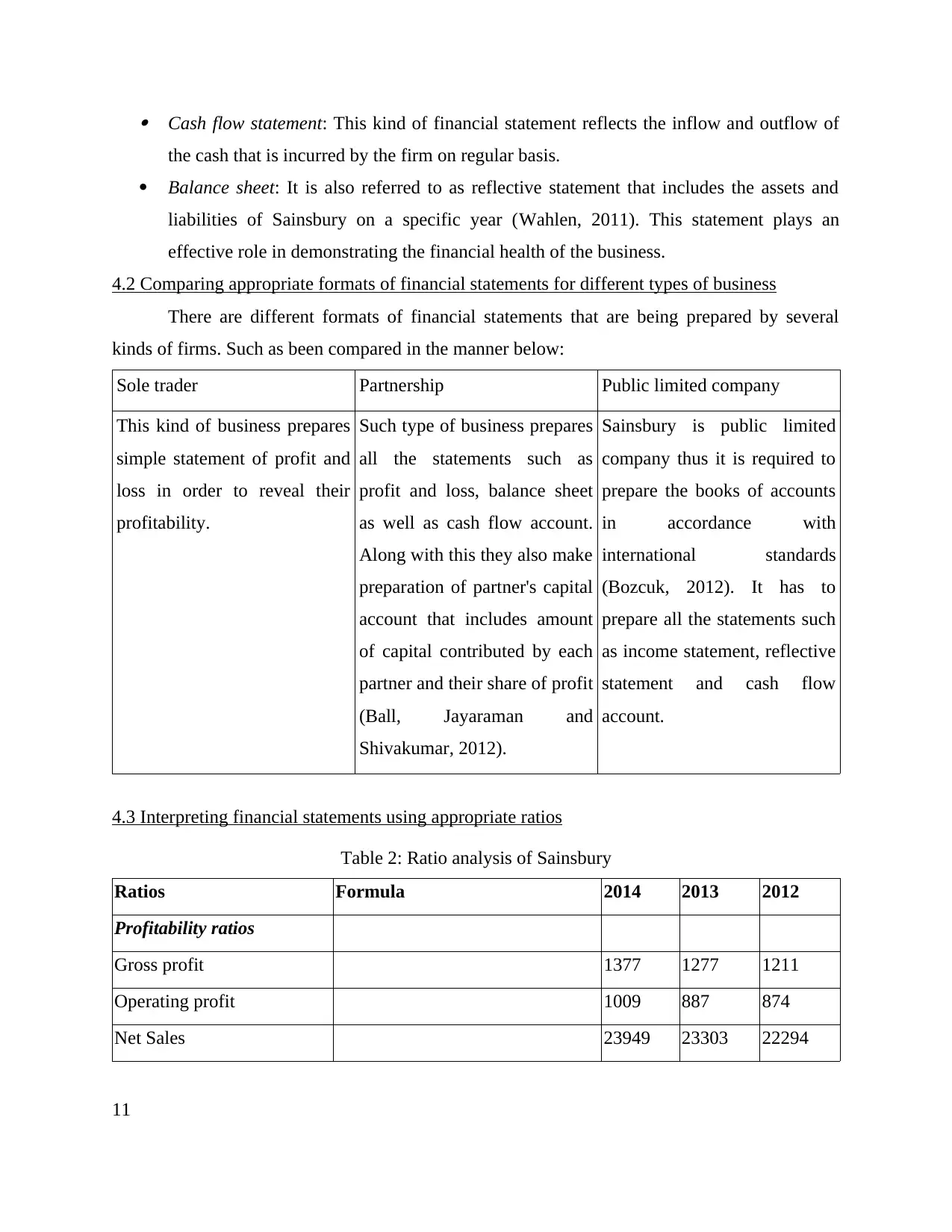
Cash flow statement: This kind of financial statement reflects the inflow and outflow of
the cash that is incurred by the firm on regular basis.
Balance sheet: It is also referred to as reflective statement that includes the assets and
liabilities of Sainsbury on a specific year (Wahlen, 2011). This statement plays an
effective role in demonstrating the financial health of the business.
4.2 Comparing appropriate formats of financial statements for different types of business
There are different formats of financial statements that are being prepared by several
kinds of firms. Such as been compared in the manner below:
Sole trader Partnership Public limited company
This kind of business prepares
simple statement of profit and
loss in order to reveal their
profitability.
Such type of business prepares
all the statements such as
profit and loss, balance sheet
as well as cash flow account.
Along with this they also make
preparation of partner's capital
account that includes amount
of capital contributed by each
partner and their share of profit
(Ball, Jayaraman and
Shivakumar, 2012).
Sainsbury is public limited
company thus it is required to
prepare the books of accounts
in accordance with
international standards
(Bozcuk, 2012). It has to
prepare all the statements such
as income statement, reflective
statement and cash flow
account.
4.3 Interpreting financial statements using appropriate ratios
Table 2: Ratio analysis of Sainsbury
Ratios Formula 2014 2013 2012
Profitability ratios
Gross profit 1377 1277 1211
Operating profit 1009 887 874
Net Sales 23949 23303 22294
11
the cash that is incurred by the firm on regular basis.
Balance sheet: It is also referred to as reflective statement that includes the assets and
liabilities of Sainsbury on a specific year (Wahlen, 2011). This statement plays an
effective role in demonstrating the financial health of the business.
4.2 Comparing appropriate formats of financial statements for different types of business
There are different formats of financial statements that are being prepared by several
kinds of firms. Such as been compared in the manner below:
Sole trader Partnership Public limited company
This kind of business prepares
simple statement of profit and
loss in order to reveal their
profitability.
Such type of business prepares
all the statements such as
profit and loss, balance sheet
as well as cash flow account.
Along with this they also make
preparation of partner's capital
account that includes amount
of capital contributed by each
partner and their share of profit
(Ball, Jayaraman and
Shivakumar, 2012).
Sainsbury is public limited
company thus it is required to
prepare the books of accounts
in accordance with
international standards
(Bozcuk, 2012). It has to
prepare all the statements such
as income statement, reflective
statement and cash flow
account.
4.3 Interpreting financial statements using appropriate ratios
Table 2: Ratio analysis of Sainsbury
Ratios Formula 2014 2013 2012
Profitability ratios
Gross profit 1377 1277 1211
Operating profit 1009 887 874
Net Sales 23949 23303 22294
11
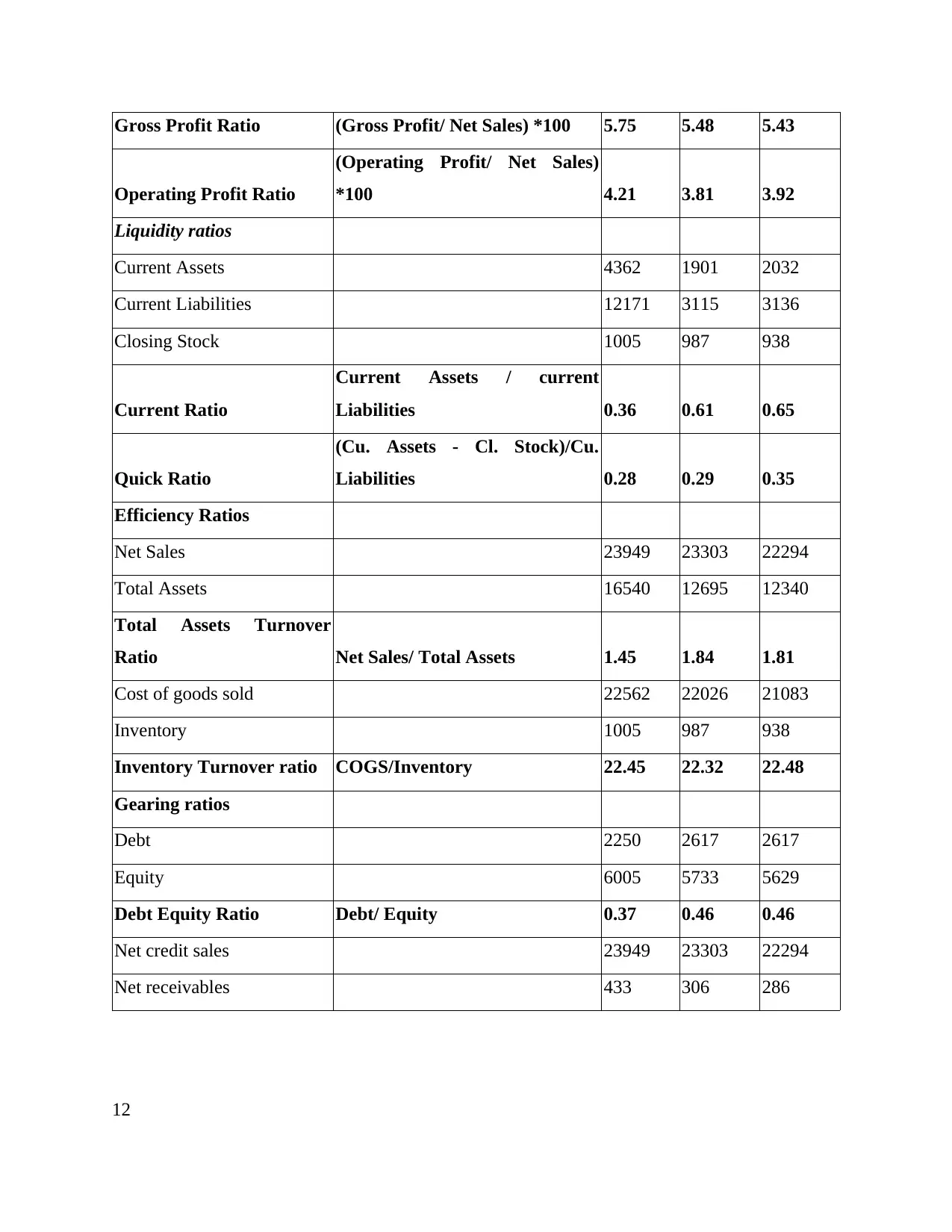
Gross Profit Ratio (Gross Profit/ Net Sales) *100 5.75 5.48 5.43
Operating Profit Ratio
(Operating Profit/ Net Sales)
*100 4.21 3.81 3.92
Liquidity ratios
Current Assets 4362 1901 2032
Current Liabilities 12171 3115 3136
Closing Stock 1005 987 938
Current Ratio
Current Assets / current
Liabilities 0.36 0.61 0.65
Quick Ratio
(Cu. Assets - Cl. Stock)/Cu.
Liabilities 0.28 0.29 0.35
Efficiency Ratios
Net Sales 23949 23303 22294
Total Assets 16540 12695 12340
Total Assets Turnover
Ratio Net Sales/ Total Assets 1.45 1.84 1.81
Cost of goods sold 22562 22026 21083
Inventory 1005 987 938
Inventory Turnover ratio COGS/Inventory 22.45 22.32 22.48
Gearing ratios
Debt 2250 2617 2617
Equity 6005 5733 5629
Debt Equity Ratio Debt/ Equity 0.37 0.46 0.46
Net credit sales 23949 23303 22294
Net receivables 433 306 286
12
Operating Profit Ratio
(Operating Profit/ Net Sales)
*100 4.21 3.81 3.92
Liquidity ratios
Current Assets 4362 1901 2032
Current Liabilities 12171 3115 3136
Closing Stock 1005 987 938
Current Ratio
Current Assets / current
Liabilities 0.36 0.61 0.65
Quick Ratio
(Cu. Assets - Cl. Stock)/Cu.
Liabilities 0.28 0.29 0.35
Efficiency Ratios
Net Sales 23949 23303 22294
Total Assets 16540 12695 12340
Total Assets Turnover
Ratio Net Sales/ Total Assets 1.45 1.84 1.81
Cost of goods sold 22562 22026 21083
Inventory 1005 987 938
Inventory Turnover ratio COGS/Inventory 22.45 22.32 22.48
Gearing ratios
Debt 2250 2617 2617
Equity 6005 5733 5629
Debt Equity Ratio Debt/ Equity 0.37 0.46 0.46
Net credit sales 23949 23303 22294
Net receivables 433 306 286
12
⊘ This is a preview!⊘
Do you want full access?
Subscribe today to unlock all pages.

Trusted by 1+ million students worldwide
1 out of 15
Related Documents
Your All-in-One AI-Powered Toolkit for Academic Success.
+13062052269
info@desklib.com
Available 24*7 on WhatsApp / Email
![[object Object]](/_next/static/media/star-bottom.7253800d.svg)
Unlock your academic potential
Copyright © 2020–2025 A2Z Services. All Rights Reserved. Developed and managed by ZUCOL.





